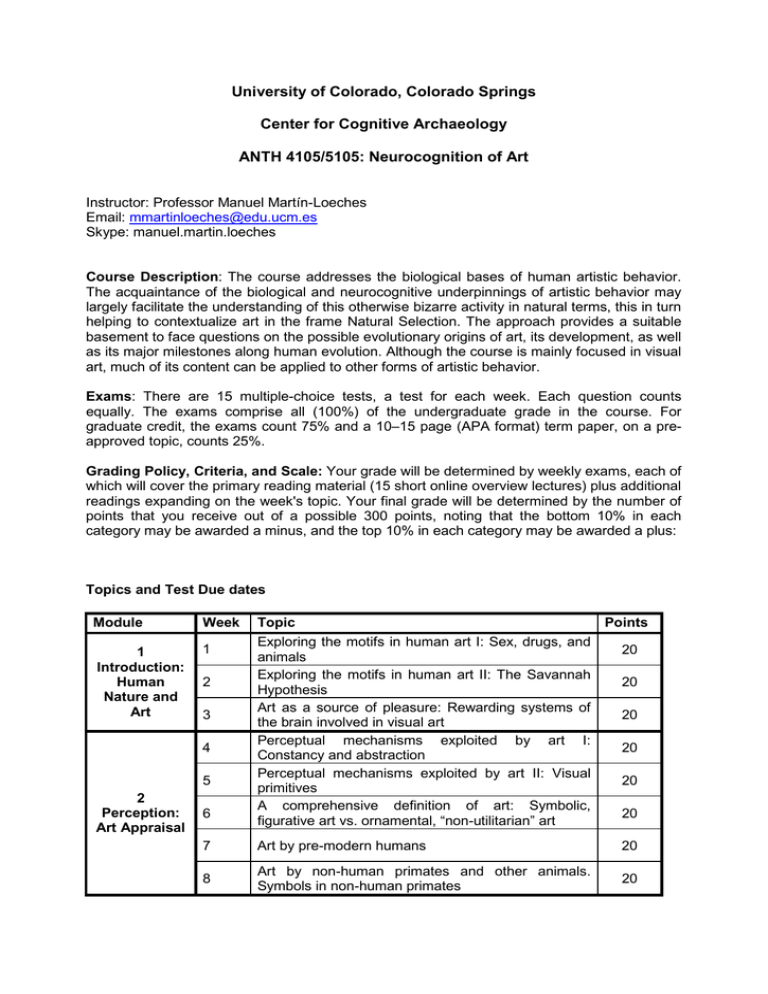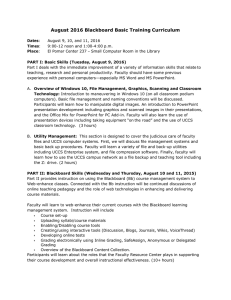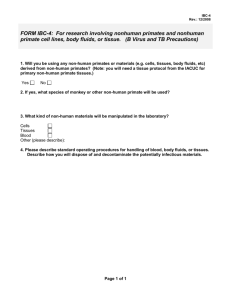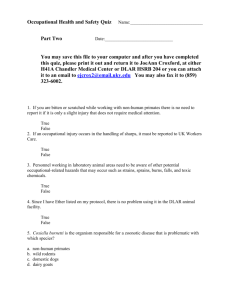University of Colorado, Colorado Springs Center for Cognitive Archaeology
advertisement

University of Colorado, Colorado Springs Center for Cognitive Archaeology ANTH 4105/5105: Neurocognition of Art Instructor: Professor Manuel Martín-Loeches Email: mmartinloeches@edu.ucm.es Skype: manuel.martin.loeches Course Description: The course addresses the biological bases of human artistic behavior. The acquaintance of the biological and neurocognitive underpinnings of artistic behavior may largely facilitate the understanding of this otherwise bizarre activity in natural terms, this in turn helping to contextualize art in the frame Natural Selection. The approach provides a suitable basement to face questions on the possible evolutionary origins of art, its development, as well as its major milestones along human evolution. Although the course is mainly focused in visual art, much of its content can be applied to other forms of artistic behavior. Exams: There are 15 multiple-choice tests, a test for each week. Each question counts equally. The exams comprise all (100%) of the undergraduate grade in the course. For graduate credit, the exams count 75% and a 10–15 page (APA format) term paper, on a preapproved topic, counts 25%. Grading Policy, Criteria, and Scale: Your grade will be determined by weekly exams, each of which will cover the primary reading material (15 short online overview lectures) plus additional readings expanding on the week's topic. Your final grade will be determined by the number of points that you receive out of a possible 300 points, noting that the bottom 10% in each category may be awarded a minus, and the top 10% in each category may be awarded a plus: Topics and Test Due dates Module Week 1 Introduction: Human Nature and Art 1 2 3 4 5 2 Perception: Art Appraisal 6 Topic Exploring the motifs in human art I: Sex, drugs, and animals Exploring the motifs in human art II: The Savannah Hypothesis Art as a source of pleasure: Rewarding systems of the brain involved in visual art Perceptual mechanisms exploited by art I: Constancy and abstraction Perceptual mechanisms exploited by art II: Visual primitives A comprehensive definition of art: Symbolic, figurative art vs. ornamental, “non-utilitarian” art Points 20 20 20 20 20 20 7 Art by pre-modern humans 20 8 Art by non-human primates and other animals. Symbols in non-human primates 20 9 3 Action: Motor Aspects of Art 4 Art and the Human Social Brain 10 11 12 13 14 15 Perception as part of the puzzle: Visual perception in human and non-human primates Musculoskeletal systems involved in art (I): human vs. non-human primates Musculoskeletal systems involved in art (II): premodern vs. modern humans Neural motor control systems involved in art: nonhuman primates, pre-modern, and modern humans Embodied human cognition: perception equates action, theory of mind, and mirror neurons Pleasure in own and others’ actions: visual art and beyond (dancing and music) Social evolutionary pressures and art 20 20 20 20 20 20 20 TOTAL 300 As an undergraduate student, your final grade will be determined by the number of points that you receive out of a possible 300 points on the quizzes: A B C D F 270-300 Points 239-269 Points 224-338 Points 209-223 Points 000-208 Points As a graduate student, your final grade will be determined by the number of points that you receive out of a possible 400 (300 points on the quizzes, plus 100 points awarded for the research paper): A B C D F 360-400 Points 319-359 Points 299-318 Points 279-298 Points 000-278 Points Readings Wk. Readings 1. Hodgson,D., & Helvenston,P.A. (2006) The emergence of the representation of animals in paleoart: Insights from evolution and the cognitive, limbic and visual systems of the human brain. Rock Art Research, 23: 3-40. Lewis-Williams, J.D, Dowson, T.A. (1988). The Signs of All Times: Entoptic Phenomena in Upper Palaeolithic Art. Current Anthropology, 29: 201-245. 2. Orians, G.H., and Heerwagen, J.H. (1992) Evolved Responses to Landscapes. In Barkow, J., Cosmides, L., and Tooby, J. (Eds.) The adapted mind: evolutionary psychology and the generation of culture. Oxford: Oxford University Press, pp. 555-580 Komar and Melamid’s http://awp.diaart.org/km/ 3. “The Most Wanted Paintings on the Web”: Biederman, I., & Vessel, E. A. (2006). Perceptual Pleasure and the Brain. American Scientist, 94: 249-255. Brown,S., Gao,X., Tisdelle,L., Eickhoff,S.B., and Liotti,M. 2011. Naturalizing aesthetics: Brain areas for aesthetic appraisal across sensory modalities. NeuroImage 58: 250-258. 4. Zeki, S. (1999) Art and the brain. Journal of Consciousness Studies, 6: 76-96. Harth, E. (1999). The emergence of art and language in the human brain. Journal of Consciousness Studies 6: 97-115. 5. Ramachandran, V.S., & Hirstein, W. (1999). The science of art. A neurological theory of aesthetic experience. Journal of Consciousness Studies, 6: 15-51. Hodgson, D. (2006). Understanding the Origins of Palaeoart: The Neurovisual Resonance Theory and brain functioning. Paleoanthropology 2006: 54-67. 6. d’Errico F., Henshilwood C., Vanhaeren M., Van Niekerk K. (2005) Nassarius kraussianus shell beads from Blombos Cave: Evidence for symbolic behaviour in the Middle Stone Age. Journal of Human Evolution, vol. 48: 3–24. Critical reading of the article in Wikipedia about Art (concept, styles, classification, purpose): http://en.wikipedia.org/wiki/Art 7. d'Errico, F., and Nowell, A. (2000). A new look at the Berekhat Ram figurine: implications for the origins of symbolism. Cambridge Archaeological Journal 10: 123-67. Kohn, M., and Mithen, S. 1999. Handaxes: products of sexual selection? Antiquity 73: 518-526. 8. Premack, D. (1975) Putting a face together. Science, 188: 228-290. Watch these videos: http://www.youtube.com/watch?v=asQcyG4QedI http://www.youtube.com/watch?v=oAvJElLFAEQ http://www.youtube.com/watch?v=a_PjV8rRgcU 9. Felleman, D.J., and Van Essen D.C. 1991. Distributed hierarchical processing in the primate cerebral cortex. Cerebral Cortex 1:1-47. Grill-Spector, K, and Malach, R. (2004). The human visual cortex. Annual Review of Neuroscience 27: 649-677 10. Marzke, M.W., and Marzke, R.F. 2000. Evolution of the human hand: approaches to acquiring, analysing and interpreting the anatomical evidence. Journal of Anatomy 197: 121-140. Diogo, R., Richmond, B.G., and Wood, B. (2012). Evolution and homologies of primate and modern human hand and forearm muscles, with notes on thumb movements and tool use. Journal of Human Evolution 63, 64-78. 11. Culley, E.V. 2006. Defining the Biomechanics of Image Production and Neanderthal Capacities for Fully Modern Human Behavior. [Link]: http://www.academia.edu/445342/Defining_the_Biomechanics_of_Image_Production_an d_Neanderthal_Capacities_for_Fully_Modern_Human_Behavior. Maki, J., and Trinkaus, E. 2011. Opponens Pollicis mechanical effectiveness in Neandertals and Early Modern Humans. PaleoAnthropology 2011: 62−71. 12. Passingham, R. 2008. What is special about the human brain? Oxford, Oxford University Press. Chapter 4: Manual skill. Masri, O.A. 2011. An essay on the human corticospinal tract: History, development, anatomy, and connections. Neuroanatomy 10: 1–4. 13. Barsalou, L.W. 2008. Grounded cognition. Annual Review of Psychology 59: 617-645. Cavallo, A., Becchio, C., Sartori, L., Bucchioni, G., and Castiello, U. 2012. Grasping with Tools: Corticospinal Excitability Reflects Observed Hand Movements. Cerebral Cortex 22: 710-716. 14. Freedberg,D.; Gallese,V. 2007. Motion, emotion and empathy in esthetic experience. Trends in Cognitive Sciences 11: 197-203. Van Loon, A.M., Van den Wildenberg, W.P.M., Van Stegeren, A.H., Hajcak, G., and Ridderinkhof, K.R. 2010. Emotional stimuli modulate readiness for action: A transcranial magnetic stimulation study. Cognitive, Affective, and Behavioral Neuroscience 10: 174181. 15. Alexander, R. (2003) Evolutionary selection and the nature of humanity. In V.Hosle & Ch. Illes (Eds) Darwinism and Philosophy. University of Notre Dame Press, South Bend, pp. 301-348. Zaidel, D.W. 2010. Art and brain: insights from neuropsychology, biology and evolution. Journal of Anatomy 216: 177-183. Extra Credit: Extra credit is not offered in this course. Graduate Requirements: Graduate students will complete a 10–15 page research paper on a topic approved by the professors by the specified due date. Due Dates and Deadlines: The syllabus in Blackboard contains the deadline for each unit and specifies the dates by which the test must be completed. For each deadline, you have until 11:59 PM on the deadline day. Remember, these are DEADLINES. You are encouraged to stay well ahead of these deadlines. The sooner you complete the work, the sooner you'll be done with the course. You must complete each unit by the specific date in the Blackboard version of the syllabus. Once that date has passed, you can still access the material in the unit, but you can no longer take the test associated with that unit. For example, if Unit 3 must be completed by Thursday, September 16, if you don't take Test 3 by 11:59 PM on September 16, you will receive a 0 for that test. Prof. Martín-Loeches’ Expectations of You: During completion of this course, you must abide by the UCCS Student Conduct Code. This code specifies what is considered proper and improper student conduct, including matters such as cheating and inappropriate behavior. Students who do not abide by the code can receive sanctions ranging up to expulsion from the course or the university. Remember that this is a 3 credit-hour course. Please plan on spending a lot of time working on just this class. This time will include reviewing lesson plans, completing online lectures, reading from your textbook, answering practice problems, verifying your work, and completing test. We suggest that you plan to spend at least 10 hours per week on average. Of course, the amount of time spent does not guarantee you any particular grade. Your letter grade will reflect the amount of material that you learned, as reflected in your test scores and the overall quality of your contributions to the course. Solving Technical Difficulties: When you're having technical difficulties (pages not loading, connectivity problems, not able to view images, things not working as they should, etc.), please contact the Blackboard Helpdesk toll-free at 877.654.8309 or online at the UCCS Blackboard Support page. The Blackboard Helpdesk is available 24 hours a day, 7 days a week. Please note this service is separate from the UCCS IT Helpdesk. Help Understanding Course Material: When you have questions regarding course policies, grading criteria, test administration, or course content, please email your professor for assistance.


